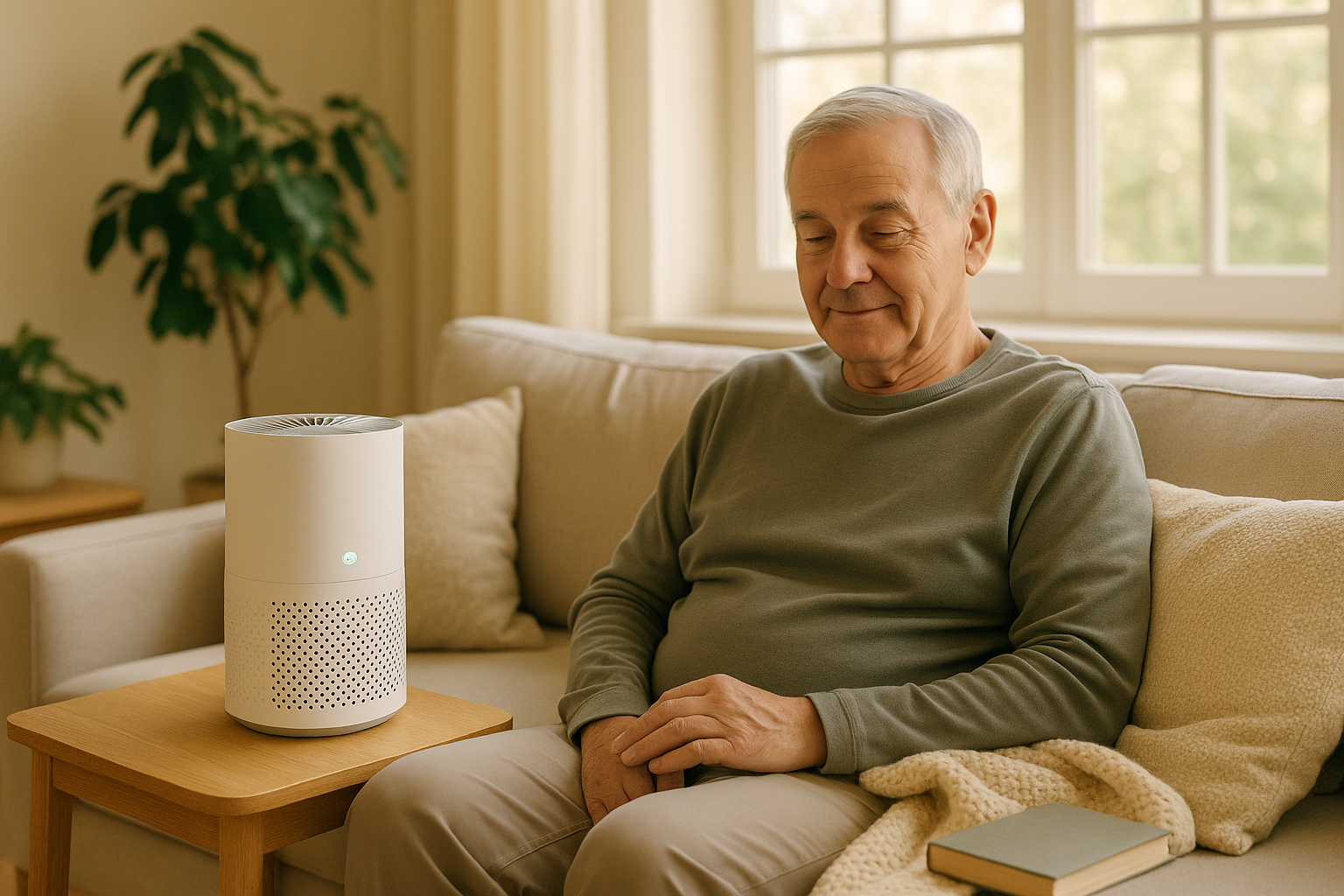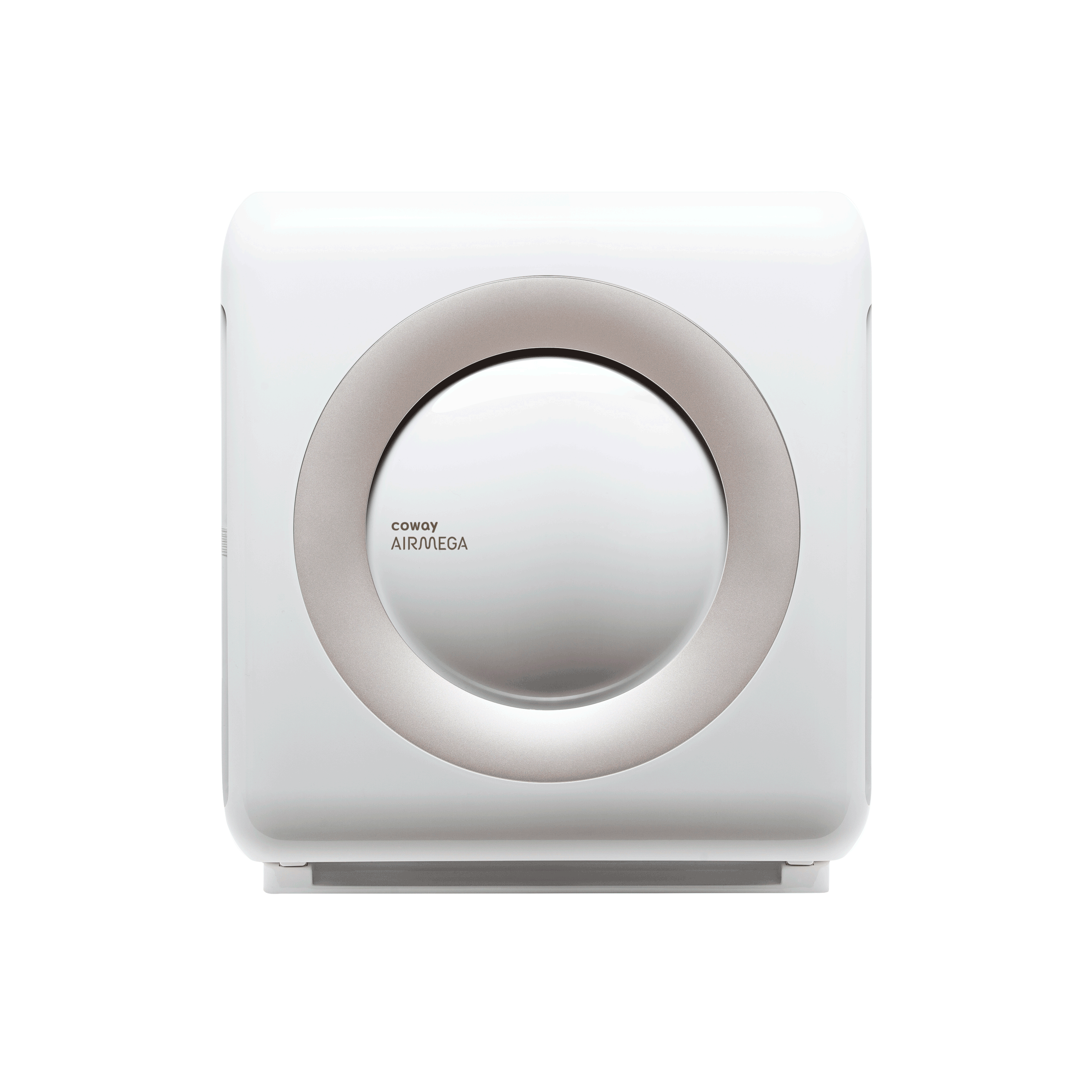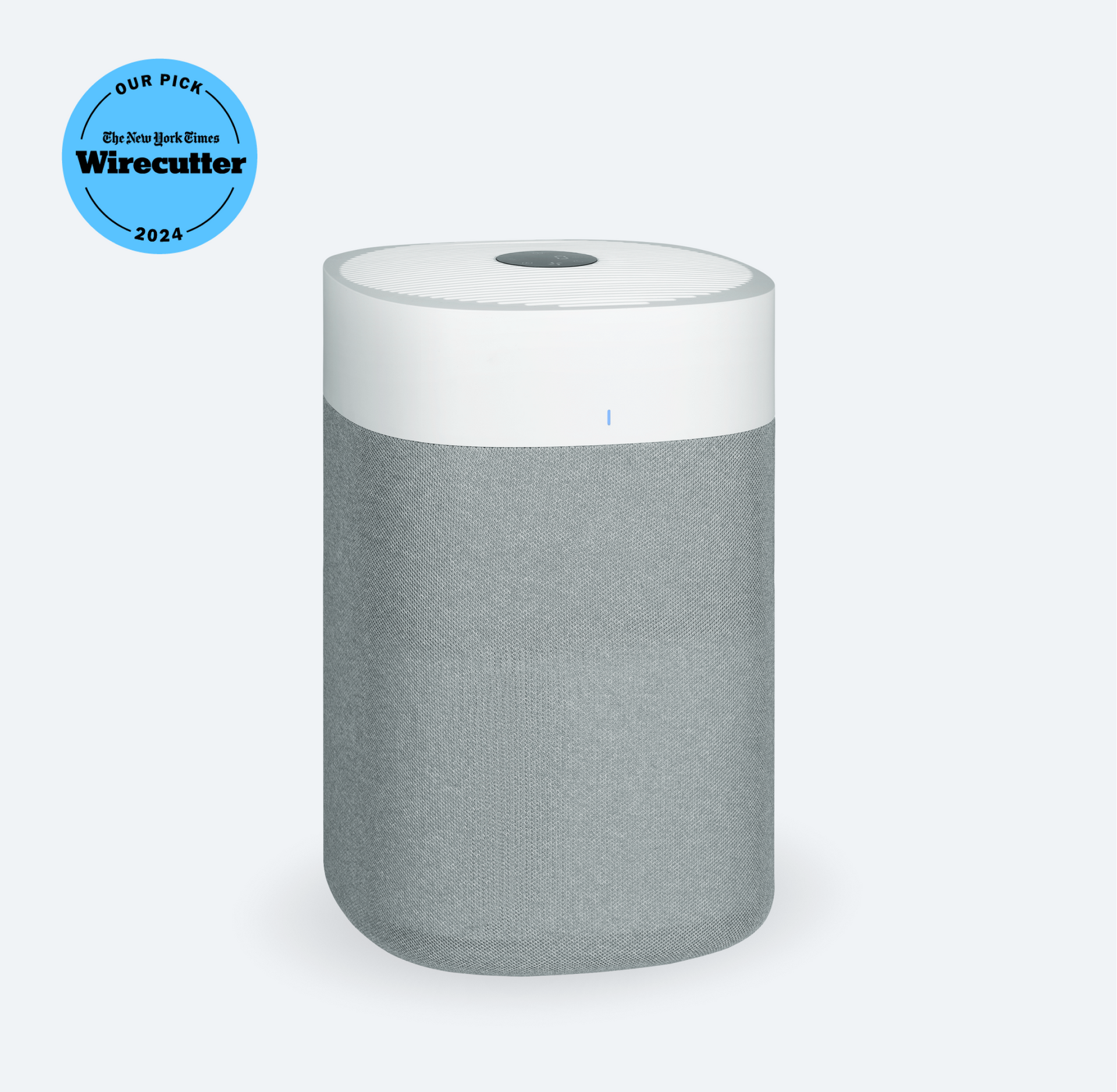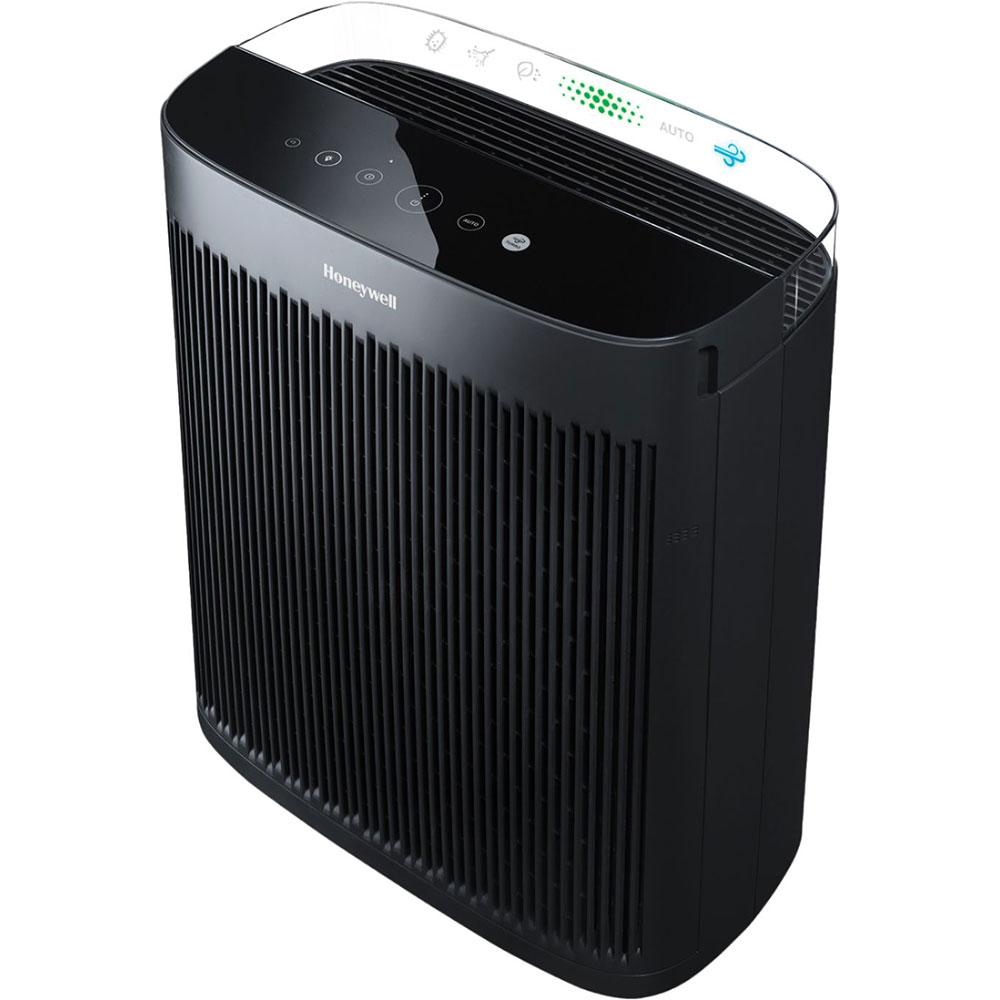If you or someone you know has COPD, improving indoor air quality can make a big difference. HEPA air purifiers are designed to remove harmful particles like dust, pollen, and pet dander that can worsen breathing issues. But not all air purifiers are created equal. Here's a quick checklist to help you pick the right one:
- Room Size: Match the purifier’s capacity (measured in square feet) to your room. Use the Clean Air Delivery Rate (CADR) to ensure it can handle the space effectively.
- True HEPA Filters: Always choose "True HEPA" over "HEPA-type" for the best particle removal.
- Sealed Design: Look for models that prevent unfiltered air from bypassing the filter.
- Activated Carbon: Essential for removing odors and chemical gases that can irritate the lungs.
- Noise Levels: Quiet operation (below 30 dB) is ideal, especially for bedrooms.
- Filter Replacement Costs: Check the price and lifespan of filters to avoid unexpected expenses.
The right air purifier can reduce respiratory symptoms, improve sleep, and create a healthier home environment. Below, we break down everything you need to know about choosing the best air purifier for COPD.
Why Should COPD Patients Use A HEPA Filter At Home? - COPD Care Collective
Room Size and Clean Air Delivery Rate (CADR)
Selecting the right air purifier for your room is crucial for managing COPD effectively. If the purifier is too small, it won’t clean the air efficiently. On the other hand, a unit that's too large may waste energy and create unnecessary noise. The solution? Match the purifier’s Clean Air Delivery Rate (CADR) to your room’s size. Start by measuring the dimensions of your space to find the right fit.
How to Measure Room Size for Air Purifiers
To determine your room’s size, multiply its length by its width to calculate the square footage. For example, a 12-by-15-foot room (180 sq ft) with an 8-foot ceiling might need a more powerful purifier if the ceiling height is greater.
Here’s a quick guide to common U.S. room sizes:
- Small rooms: 100–200 sq ft (like bedrooms or home offices)
- Medium rooms: 200–400 sq ft (living rooms or master bedrooms)
- Large rooms: 400–600+ sq ft (open floor plans or great rooms)
For managing COPD, ensuring proper air purification in bedrooms is especially important.
Understanding CADR Ratings
Once you know your room size, use CADR ratings to gauge how effectively an air purifier can clean the air. CADR, or Clean Air Delivery Rate, measures the volume of purified air produced per minute, expressed in cubic feet per minute (CFM). These ratings are standardized by the Association of Home Appliance Manufacturers (AHAM) through independent testing [1][2][3].
CADR ratings evaluate how well a purifier removes three types of particles:
- Smoke CADR: Indicates efficiency in removing small particles.
- Dust CADR: Reflects performance against larger particles.
- Pollen CADR: Measures effectiveness with medium-sized particles.
The maximum CADR ratings are 400 for dust and 450 for smoke and pollen [3]. Starting in 2024, manufacturers will also report a PM2.5 CADR rating, which combines smoke and dust scores to represent fine particulate removal [2].
To calculate the minimum CADR needed for your room, follow the "2/3 rule": multiply the room’s square footage by 0.67. For example, a 300 sq ft room would need a CADR of at least 200 CFM [2]. For quicker air cleaning, especially for COPD, consider choosing a purifier with a CADR that exceeds this baseline.
It’s worth noting that CADR ratings reflect performance at the purifier’s highest fan speed [2][3]. If you prefer quieter settings at night, the actual clean air delivery will be reduced.
| Room Size | Minimum CADR Needed | Recommended CADR |
|---|---|---|
| 150 sq ft | 100 CFM | 120–150 CFM |
| 300 sq ft | 200 CFM | 240–300 CFM |
| 450 sq ft | 300 CFM | 360–400 CFM |
EnergyStar certification, based on CADR, ensures air purifiers meet strict energy efficiency standards. Units rated at 150 CFM or higher must achieve a minimum efficiency ratio of 2.9 CADR per watt [2]. Starting in 2024, EnergyStar certification will become a federal requirement for air purifiers sold in the U.S. [2].
True HEPA vs HEPA-Type Filters
When choosing an air purifier to help manage COPD symptoms, you'll come across two main types of filters: True HEPA and HEPA-type. Knowing the difference is crucial - it can mean the difference between effective air cleaning and wasting your money. These filters vary significantly in how well they perform.
What Defines a True HEPA Filter?
If you've got the right room size and CADR (Clean Air Delivery Rate), the type of filter you choose becomes a key factor in managing COPD symptoms. A True HEPA filter is designed to remove 99.97% of particles measuring 0.3 microns or larger, a standard verified by the U.S. Department of Energy. Why focus on 0.3 microns? Because this size, known as the most penetrating particle size (MPPS), is the hardest for filters to trap.
For those with COPD, capturing these tiny particles is critical. True HEPA filters excel at removing dust mites, pet dander, pollen, mold spores, and even some bacteria and viruses - all common irritants that fall within the 0.3 to 10-micron range.
How does it work? True HEPA filters rely on densely packed fibers that trap particles through three mechanisms:
- Impaction: Larger particles collide directly with the fibers.
- Interception: Particles that follow air streams too closely get caught by the fibers.
- Diffusion: The smallest particles move erratically and eventually stick to the fibers.
This multi-layered approach makes True HEPA filters highly effective at cleaning the air.
Why You Should Avoid HEPA-Type Filters
Filters labeled as HEPA-type, HEPA-like, or HEPA-style don’t meet the same stringent standards as True HEPA filters. While these alternatives may capture 85% to 95% of particles, they fall short of the performance needed for effective COPD management. That missing 5% to 15% of particles can include exactly the kind of irritants that worsen symptoms.
Why do these filters exist? Simply put, they're cheaper to produce. Manufacturers often use terms like "HEPA-type" to cut costs and offer lower-priced products while maintaining higher profit margins. Unfortunately, this comes at the expense of performance.
To avoid disappointment, always check for explicit True HEPA certification in the product specifications. Reputable manufacturers will clearly display this certification and often include third-party testing results. Be cautious of vague terms like "HEPA-grade" or "hospital-grade HEPA" without the "True HEPA" label - they’re often just marketing gimmicks.
| Filter Type | Efficiency Rate | Particle Size | COPD Suitability |
|---|---|---|---|
| True HEPA | 99.97% | 0.3 microns+ | Excellent |
| HEPA-Type | 85-95% | 0.3 microns+ | Poor to Fair |
| Basic Pleated | 60-80% | 1.0 microns+ | Not Recommended |
When it comes to air purifiers, the filter is the core of the system. Investing in a True HEPA filter may cost more upfront, but it guarantees the level of particle removal needed to help manage COPD symptoms effectively. Up next, we’ll dive into design features and additional filtration components that can further enhance air quality for COPD management.
Sealed Body Design for Better Filtration
A True HEPA filter is only as effective as the design around it. If air can bypass the filter, even the best HEPA technology won’t protect you. That’s where a sealed body design becomes essential - especially for managing COPD. This design ensures that every bit of air entering the purifier is forced through the filter, leaving no room for unfiltered air to sneak back into your space.
Think of it like a leaky pipe: no matter how good the filter is, any gaps or loose fittings allow contaminants to slip through. For someone with COPD, even small amounts of unfiltered air can worsen symptoms or trigger breathing issues. A sealed body design eliminates this problem by using rubber gaskets, foam seals, and precision-fitted parts to create an airtight system. When the purifier’s fan pulls in air, it has no choice but to pass through the HEPA filter before being released back into the room. This ensures that every bit of air is thoroughly cleaned.
The weakest points in poorly designed air purifiers are often loose filter frames, gaps around the filter housing, unsealed seams, or poorly fitted gaskets. These flaws can compromise even a high-quality HEPA filter's performance, allowing unfiltered air to bypass the system.
High-end models showcase how effective proper sealing can be. For example, some units with tightly sealed bodies can remove 99.5% of particles as small as 0.003 microns - smaller than most viruses, including SARS‑CoV‑2. These models are often individually tested for airtightness before shipping to ensure their performance [5].
Cheaper air purifiers, on the other hand, often suffer from what’s called bypass leakage. Here’s a comparison to break it down:
| Design Feature | Sealed Body (e.g., IQAir HealthPro Plus) | Non-Sealed Design |
|---|---|---|
| Filtration Efficiency | 99.5% at 0.003 microns | Drops significantly due to leaks |
| Air Pathway | All air forced through filter | Some air escapes filtration |
| COPD Suitability | Highly recommended | Not recommended |
When choosing an air purifier, look for visible signs of a sealed design, like rubber gaskets around the filter edges or snug-fitting parts. Many reputable brands, including Eoleaf, certain Dyson models, and IQAir, are known for their sealed body designs. These often feature medical-grade HEPA filters paired with robust gaskets to prevent air leakage, making them a top choice for individuals managing COPD [4].
Of course, sealed designs come with a few trade-offs. They typically cost a bit more upfront and may require a more careful approach to filter replacement, as maintaining those tight seals is crucial. However, the added protection they provide far outweighs these minor inconveniences, especially for those prioritizing lung health.
To keep your purifier performing at its best, inspect the seals and gaskets regularly and follow the manufacturer’s maintenance guidelines. This ensures that your air purifier continues to deliver the clean air your lungs need.
Activated Carbon for Odors and Gases
HEPA filters are excellent at trapping particles, but they fall short when it comes to gaseous pollutants. That’s where activated carbon filters step in. These filters are specially designed to absorb and trap odors, chemical fumes, and volatile organic compounds (VOCs) that HEPA filters can't handle. Together, they create a powerful combination, addressing both particles and gases for a more complete air purification system.
For individuals with COPD, even trace amounts of gaseous pollutants can aggravate symptoms, making activated carbon filtration an essential tool in managing air quality.
"Activated Carbon Filtration absorbs gaseous pollutants like VOCs, cooking odors, and chemical fumes that can trigger COPD symptoms even when present in small amounts." - Air Oasis [6]
Volatile Organic Compounds (VOCs) are particularly troublesome for COPD sufferers. These gases are released from everyday items such as furniture, carpets, paint, cleaning products, and even cooking. They linger in the air, often unnoticed, but can significantly impact respiratory health.
Activated carbon works by using its microscopic pores to chemically bind with gas molecules. Think of it as a sponge that soaks up odors and fumes, leaving the air cleaner and safer to breathe.
"Activated Carbon: These filters can purge odors and volatile organic compounds (VOCs) from the air - ideal for COPD patients sensitive to certain smells or chemicals." - IQAir Staff Writers, IQAir [7]
When HEPA and activated carbon filters are combined in a single unit, they provide comprehensive air purification. HEPA filters trap particles like dust, pollen, and mold spores, while the activated carbon tackles odors and gases. This dual-filtration system ensures your air purifier addresses both major triggers for COPD symptoms.
| Filter Type | What It Removes | What It Misses |
|---|---|---|
| HEPA Only | Dust, pollen, smoke particles, mold spores | VOCs, cooking odors, chemical fumes |
| Carbon Only | Odors, gases, some VOCs | Fine particles, allergens, bacteria |
| HEPA + Carbon | Broad-spectrum removal of both particles and gases | None significant for COPD triggers |
For optimal results, consider placing your air purifier near areas prone to odors, such as the kitchen. By addressing both particles and gases, this approach not only reduces COPD flare-ups but also promotes steadier breathing and an improved quality of life.
sbb-itb-3e96dba
Noise Levels and Sleep Use
After considering filtration efficiency, it’s essential to think about user comfort - especially noise levels. Noise doesn’t just disrupt sleep; it can also worsen COPD symptoms. That’s why finding a quiet air purifier is so important for maintaining both clean air and restful sleep.
Air purifiers typically produce between 50–60 dB on high settings and 30–40 dB on lower settings. The quietest models can go as low as 20 dB[9]. For reference, a typical bedroom at night measures around 30 dBA[12], so keeping the noise from an air purifier below that threshold helps ensure better sleep quality.
Quiet Operation for Better Sleep
Experts suggest choosing air purifiers with noise levels under 30 dB to avoid disturbing sleep[8]. Many modern air purifiers offer features like sleep modes or adjustable fan speeds to keep noise levels down during the night[8][11]. For instance, the Alen BreatheSmart 45i operates at just 23 dB on its lowest setting - similar to the sound of rustling leaves[9]. Similarly, Daikin air purifiers in quiet mode stay within the 21–23 dB range[12].
Another tip: opting for a larger air purifier can be helpful. Larger units often clean the air efficiently at lower fan speeds, which means they’re quieter[10]. Noise levels above 30 dB, on the other hand, can interfere with sleep, especially for light sleepers.
| Noise Level (dB) | Sound Level Equivalent | Bedroom Suitability |
|---|---|---|
| 20–25 dB | Rustling leaves, quiet whisper | Excellent – Perfect for sleep |
| 26–30 dB | Soft humming, library quiet | Good – Minimal sleep disruption |
| 31–40 dB | Quiet office, refrigerator hum | Fair – May disturb light sleepers |
| 41+ dB | Normal conversation, busy office | Poor – Likely to disrupt sleep |
When selecting an air purifier, aim for one that balances effective air cleaning with quiet operation - this ensures both COPD triggers are managed and sleep remains undisturbed.
Filter Replacement Costs and Schedule
Keeping up with regular filter changes is crucial for maintaining your air purifier's efficiency and protecting your respiratory health. For COPD patients, understanding when and how to replace filters, along with managing the associated costs, is an important part of ensuring the device continues to meet your air quality needs.
When to Replace Filters
Stick to the replacement schedule recommended by the manufacturer, as the lifespan of HEPA and carbon filters can vary depending on usage and environmental factors. However, there are clear signs that can signal the need for an earlier replacement:
- Visible dirt or discoloration: If the filter looks dirty or blackened, it's time for a change [13].
- Reduced airflow or louder fan noise: These signs often indicate a clogged filter [23, 24, 27].
- Persistent odors: If unpleasant smells linger, the carbon filter may be saturated [23, 24, 26, 27].
- Increased dust or worsening allergy symptoms: These can suggest the filter is no longer doing its job effectively [26, 27].
For COPD patients, monitoring indoor air quality is especially important. According to the World Health Organization, indoor PM2.5 levels should stay below 10 micrograms [14]. If your air quality monitor consistently detects higher levels, it's a strong indicator that your filter needs replacing [25, 27].
Filter Replacement Costs
The cost of replacing filters can vary widely depending on the model and type of filter your air purifier uses. HEPA filters, carbon filters, and combination filters (which include both HEPA and carbon layers) all have different price points and replacement intervals. These recurring expenses should be factored into your budget.
Running a dirty filter doesn't just compromise air quality - it can also reduce your purifier's efficiency and increase energy consumption by up to 15% [15]. To avoid unexpected expenses, consider calculating your potential annual filter costs based on the specific model you own. This approach helps you plan ahead while ensuring your air purifier continues to deliver the clean air essential for COPD management. Regular maintenance and cost planning are key to maintaining a healthy indoor environment.
Top 3 Air Purifiers for COPD by Room Size
Choosing the right air purifier for your room size is key to maintaining effective air cleaning while keeping energy use and noise under control. Based on CADR ratings and room coverage guidelines, here are three top-rated models tailored for COPD management. These options are designed to meet the needs of small, medium, and large rooms, offering True HEPA filtration and quiet operation - both critical for respiratory health.
| Feature | Best for Small Rooms | Best for Medium Rooms | Best for Large Rooms |
|---|---|---|---|
| Model | Levoit Core 300 | Coway AP-1512HH Mighty | Blueair Blue Pure 211+ |
| Room Coverage | Up to 219 sq ft | Up to 361 sq ft | Up to 540 sq ft |
| CADR Rating | 141 CFM | 246 CFM | 350 CFM |
| Noise Level | 24-50 dB | 24.4-53.8 dB | 31-56 dB |
Levoit Core 300: Best for Small Rooms
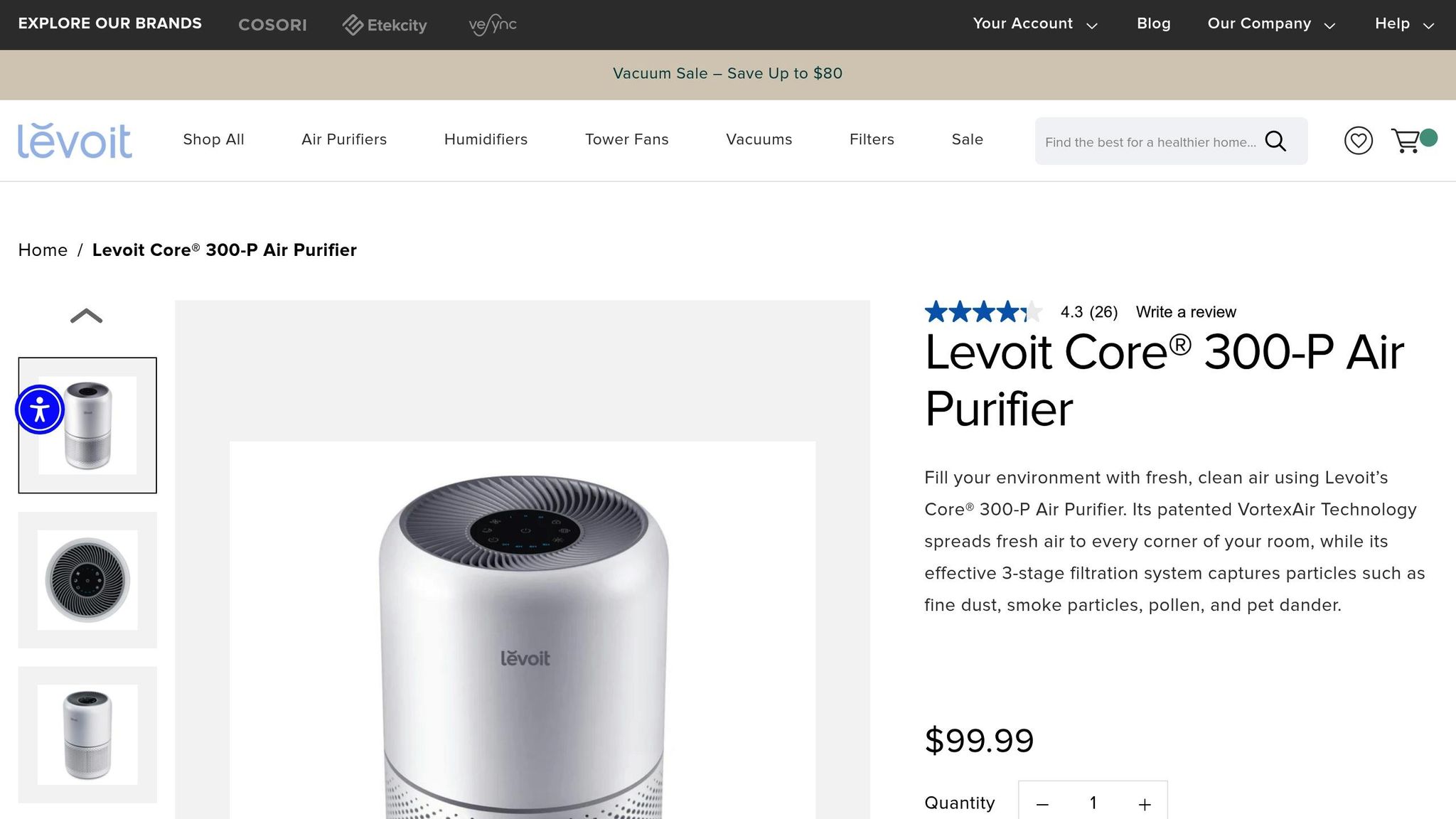
The Levoit Core 300 is a compact yet powerful choice for small spaces. It features a three-stage filtration system that includes a washable pre-filter, a True HEPA filter, and an activated carbon filter. This setup is ideal for removing particles and odors, making it a great option for COPD patients. Operating as quietly as 24 dB, it ensures a peaceful environment while effectively cleaning the air.
Coway AP-1512HH Mighty: Best for Medium Rooms
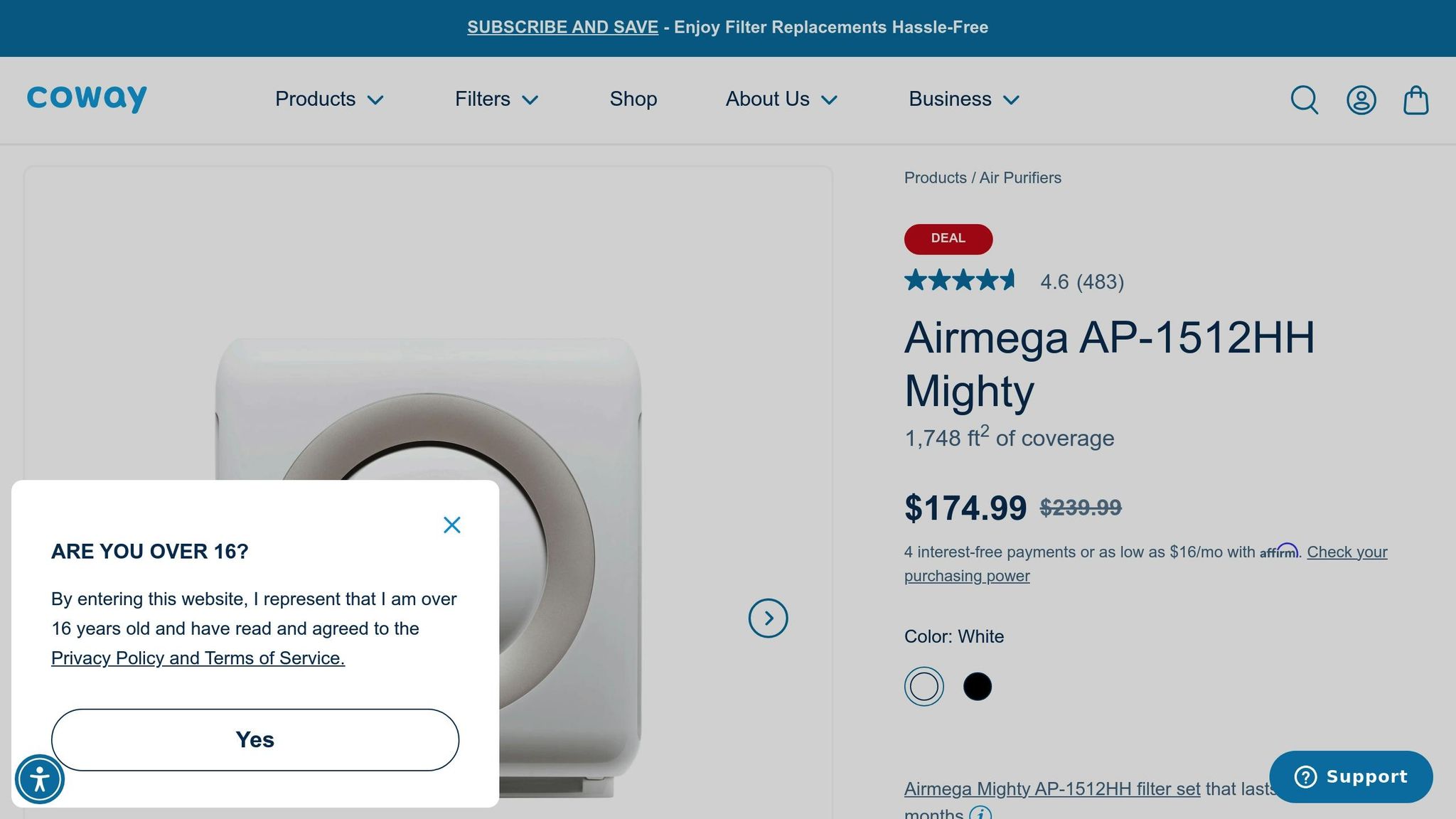
For medium-sized rooms, the Coway AP-1512HH Mighty stands out with its four-stage filtration system, which includes an optional ionizer. An air quality indicator provides real-time feedback, changing colors to reflect current conditions. The auto mode intelligently adjusts the fan speed based on air quality, offering a balance between performance and energy savings. This model is perfect for those seeking both functionality and convenience.
Blueair Blue Pure 211+: Best for Large Rooms
The Blueair Blue Pure 211+ is designed for large spaces, delivering a high CADR of 350 CFM while maintaining quiet operation. Its 360-degree air intake ensures efficient air circulation, and a simple one-button control makes it incredibly user-friendly. This purifier is ideal for spacious areas where thorough air cleaning is essential.
Key Considerations
All three models are built with sealed designs to ensure only clean, filtered air is released. They include activated carbon layers to tackle odors, cooking smells, and volatile organic compounds, which can aggravate respiratory conditions. When choosing the best fit, start by matching the purifier to your room's square footage. For optimal performance, consider factors like ceiling height and airflow. Opting for a purifier rated for a slightly larger space than your room can enhance efficiency, reduce noise at lower fan speeds, and extend filter life while lowering overall costs.
How to Choose the Right HEPA Air Purifier for COPD
When selecting a HEPA air purifier for COPD, it’s essential to focus on features that align with your specific needs. Key factors include room size, filter type, sealed design, odor control, noise levels, and overall costs.
Start by measuring your room to determine the appropriate purifier size. Look for a unit with a Clean Air Delivery Rate (CADR) that matches or exceeds the room's square footage. A purifier designed for larger spaces often runs more quietly and extends the life of its filters. Make sure the purifier is True HEPA certified to ensure it captures the smallest particles effectively. Additionally, check for a sealed design to prevent air from bypassing the filter.
If odors are a trigger, consider a model with an activated carbon filter to neutralize smells. For noise-sensitive environments, choose a purifier that operates below 30 dB on its lowest setting, as this won’t disrupt sleep. Units producing over 50 dB might feel intrusive during quieter moments.
Long-term costs are another critical consideration. Look into the price of replacement filters and their recommended replacement frequency. Some filters need changing every 3–6 months, while others can last up to 18 months. Combine these ongoing expenses with the initial purchase price to get a clear picture of the total cost.
Finally, prioritize based on your environment and personal needs. For instance, someone with a small, quiet bedroom will likely value low noise levels and compact designs, while someone managing a large living area with frequent cooking may prioritize odor control and coverage.
Use these guidelines to evaluate and compare different models effectively.
FAQs
To find the right size HEPA air purifier for managing COPD, start by measuring your room's dimensions in feet to calculate its square footage. Once you know the size, match it with a purifier designed for that space:
- Small rooms: Covers up to 200 sq. ft.
- Medium rooms: Handles 201–399 sq. ft.
- Large rooms: Suitable for 400 sq. ft. or more
If you're dealing with a very large area, consider either multiple units or a high-capacity purifier capable of covering spaces up to 1,600 sq. ft. Picking the appropriate size is key to ensuring the purifier works effectively, helping to improve indoor air quality and providing better support for managing COPD.
True HEPA filters are built to capture 99.97% of particles as small as 0.3 microns, adhering to rigorous air purification standards. On the other hand, HEPA-type filters - although similar in appearance - are less efficient, often missing smaller particles and falling short of the strict HEPA criteria.
For those managing COPD, True HEPA filters are a critical choice. They effectively trap tiny pollutants like dust, pollen, mold spores, and bacteria - common irritants that can aggravate respiratory symptoms. HEPA-type filters, however, may not offer the same level of air cleaning, making them a less dependable option for improving air quality and supporting respiratory health.
A sealed body design plays a crucial role in air purifiers, especially for individuals with COPD. This design ensures that every bit of air goes through the filters, preventing any unfiltered air from leaking back into the room. The result? A cleaner, safer space free from pollutants, allergens, and irritants - key for protecting sensitive lungs.
To find out if an air purifier includes this feature, look for terms like sealed casing, airtight design, or sealed housing in the product specifications or description. Manufacturers often emphasize this in their marketing. Additionally, user reviews can be a great resource - keep an eye out for comments about how well the purifier contains and filters air.

